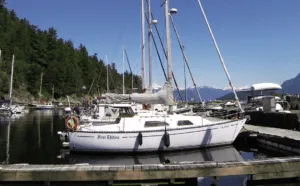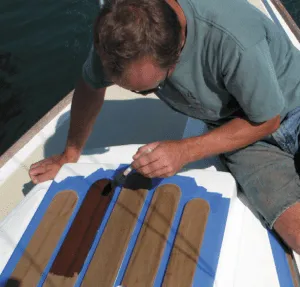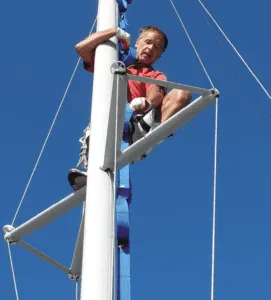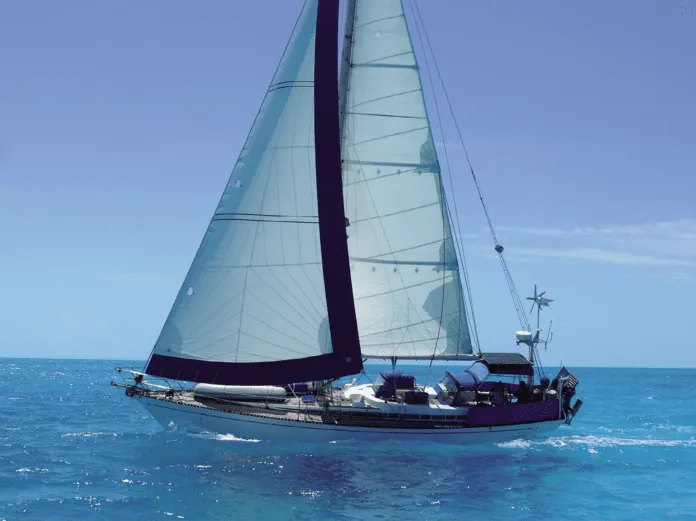BLANKET WINCH SERVICE
Regarding your blog post “Simple Tips on Servicing Your Sailboat Winches,” I do my winches every two years when the boat is on the hard. It is easier to chase loose parts that way. Use a blanket or sheet to line your deck and lifelines for containment. I use diesel to degrease and two buckets. I disassemble one winch and put all the parts in a bucket. My wife degreases them with a parts brush and while she is doing one winch, I am doing the next winch in the second bucket. We swap buckets and so goes the process. I have 11 winches to do. Harken springs fit most winch pawls. I have used Harken, Andersen and Lewmar winch greases and that is the order I like them in. There are others, but heat and seawater are the enemies, and I try and get the best grease I can.
Christopher Harry
CT49 Scintilla
Seattle, WA
A CARDBOARD WINCH ASSISTANT
Regarding your blog post, “Simple Tips on Servicing Your Sailboat Winches,” when overhauling a winch that can’t be easily removed and must be rebuilt in place, I start with a small cardboard box about 16” x 16” x 6” or so. I cut a hole in the middle of the box the diameter of the winch, place the box over the winch and tape it in position. Then when a pawl falls out, as it often does, or a spring flies out, as it usually does, there’s a good chance the box will catch it. I’ll also note that overhaul time is a good opportunity to examine the installation of the winch. These are not symmetrical devices, and there is a correct orientation for installation. This is a good time to check the winch orientation and correct it.
Alan Rothenbush
First Edition, Windward 850
Madeira Park, B.C.

servicing winches aboard his Windward 50, First Edition.
PAINTING JIB
Regarding your report on painting a suncover on a furling headsail (see “The Case of the Painted Jib,” PS January 2020), I have had a weatherstrip on my genoa for two years painted with Dulux Weathershield acrylic house paint in white. So far no problems at all. I converted the old sail from hanks to a furler and could not justify the cost of putting on a fabric strip. For reference regarding weathering, I am located in New Zealand.
Graeme Faulkner
New Zealand
KUDOS TO STERIPEN
Regarding your blog post “A DIY Water Filter,” drinking water is too important to be guessing at. I keenly appreciate the low cost DIY thinking of your approach. Once the water is filtered with what I have available, I and all on my boat use a Steripen just before drinking. This is a proven UV device that doesn’t cost much. Some years back, the company was acquired by Katadyn, a top name in onboard water filtration worldwide. I never drink water from any tank until I use the Steripen as a final step. It’s a time consuming hassle, but so is the hospital. The cost is about $50. I insist that all who come aboard overnight have one in their pocket.
Bruce McElya
via PS Online
WINCH WISDOM
Regarding your blog post, “Simple Tips on Servicing Your Sailboat Winches,” I’ve found the hardest part is the initial cleaning, particularly if it is the first time servicing a new-to-me boat. Going light on grease application also helps minimize cleanup on the next service. WD40 is another alternative for removing tough grease and dirt. Doing the clean up in a paint roller tray helps drain and dry parts. Take pictures during disassembly as some winches can be a puzzle to put back together! I’ll second the advice for taking a look at winch installation as I’ve learned at least for Harken winches the orientation of line entry and gear placement is important for proper operation.
John MacKenzie
via PS Online

SEWING MAINSAIL SUCCESS
Regarding your report on mainsails, (see “Taming the Main: Sail-Handling Systems for Bigger Mainsails” PS February 2008), we have a large full-batten main with 20-foot boom and 64-foot mast on our ketch. Taming it was a priority for the two of us, since the alternative—scrambling across our wheelhouse roof grabbing at a flapping sail and swinging boom—seemed really dangerous. We sewed our own Stack Pack system, using a mix of the best ideas from Sailrite’s DIY instructions, and the Mac Pack and Doyle Stack Pack systems. If you are into sewing canvas work and really like planning and designing, this is a great project where you end up with something better than you can buy. We sewed in custom straps so it can be totally rolled and stowed on the boom when we are on sails longer than a day or two to prevent chafe.
One item that really makes it work well for us is the 20-foot-long #5 zippers we got from Paskal in Australia. These are very expensive to ship to the USA, but worth it. These zippers are twice the size of the #10 zips that you see on most canvas work and they open completely like a jacket’s zipper.
The stainless pulls do not bind and salt does not affect the zipper operation. The key feature is that the cover zips closed starting from the mast running to the boom end, so the zipper helps compact and stuff the sail as it closes. This is the opposite direction of all other zipper systems and a big reason it works well. We can open the sail cover fully while standing clipped in at the mast in about 15 seconds using the “laundry line” pully system attached to the zipper pull.
When stowing, also while at the mast, we get it about ¾ closed in the same 15 seconds before it jams on some sail folds sticking out. These need a simple tuck to slide the zipper past. This is still much easier, safer and quicker than before. Getting up on the wheelhouse roof is rarely if ever needed. If you have a very tall boom with hard access, I would consider the Paskal zipper installed this way. The stack pack also holds and stows the three sets of slab reefing lines which used to be a spaghetti mess on the wheelhouse roof.
One other thing that really helps with taming our large main is that we have all halyards and slab reefing on the mast, old school style. With our set up I can jump the main up to within about two feet of the top in less than a minute before having to wrap the halyard on the dedicated self-tailing winch (mounted on the mast) to winch the last foot or two and do the final tensioning. By raising it fast, and having a clear view of the process, catching a batten end on the stack pack’s lazy jack lines is rarely a problem and easily fixed.
I can do this solo (using the Pelagic autopilot remote fob for keeping the boat turned into the wind) with this very large full baton sail because I removed the halyard clutch from the mast that was adding too much friction. Friction is now only from the single sheave at the top of the mast (and the regular sail slugs).
I feel sorry for all the more modern boats with all lines led back to the cockpit where you have to slowly grind up the majority of the main. Ditto for the one in-mast furling system I tried which seemed to be a delicate two-person grinding operation to prevent binding the sail as it is wrapped up hidden inside the mast. Typically, you have to go to the mast to sort something out anyway, so as long as you have a good jackline system, why not consider doing everything at the mast? Sheaves, blocks and clutches add a huge amount of friction (and expense). Experiment without them and see what you think.
Since I am a sewing fool, I also made large custom rope bags mounted on the mast just below the winches to store the halyard tails. They are mesh at the bottom for drainage, made of a stiff rubberized fabric and are about 8 inches in diameter and 16 inches tall with a Sunbrella draw string top. With the top of the bag opened all the way I drop the halyard in as I jump the sail up. When the main is up and all the excess halyard is stuffed in the bag, I just pull the drawstring top closed. When I drop or reef the main, the halyard automatically feeds out of the smaller drawstring opening without any twists or snarls. There is no pile of spaghetti at your feet to get tangled in.
I like this safe and very time efficient system so much that I am rigging smaller rope bags for other reefing and furling lines tails around the boat. The key is keeping the bags diameter just small enough to not let the rope double back inside it and get snarled. For a ½-inch halyard, the 8” diameter seems right.
Sometimes simple, fast, and easy is also safer.
via PS Online
Grant Calverley
TIDES MARINE TRACK WORKS
Regarding your report on “Taming the Mainsail,” in addition to the lazy jacks/cover systems, I found the Tides marine sail track/slides system a huge help. As a senior, I could easily haul my full batten main all the way up on my Cal ll-46 by hand. Then just a quick single crank for tension. To drop the sail, I simply free the halyard and it literally drops into the cover. This serves fine until you are anchored or docked. Then finish I just finish tucking it in and zip! And you don’t even have to go up the mast to install it. Just slide over old track and fit the new slides on the sail.
Fred Read
Tartan 37, Merry Dolphin
Oriental, North Carolina

WOOD FINISH

RIG INSPECTION




































